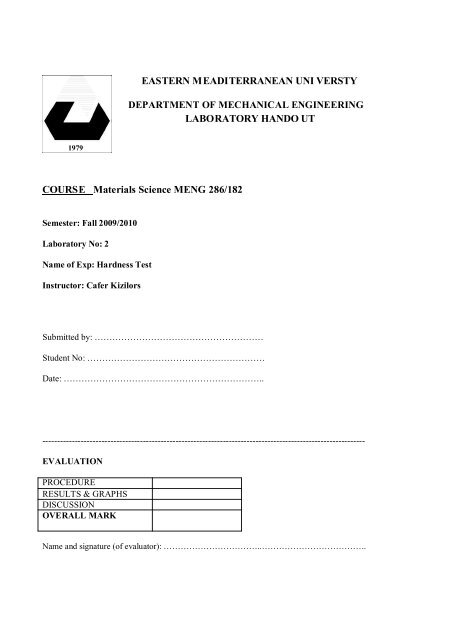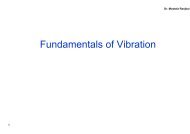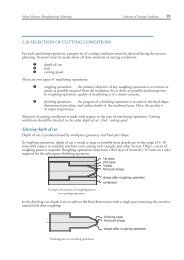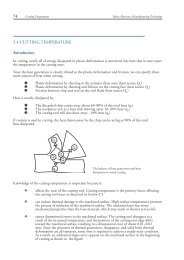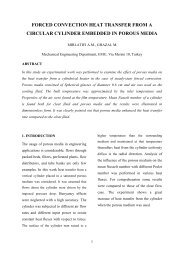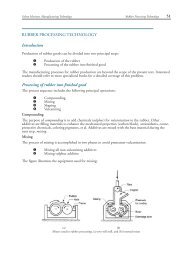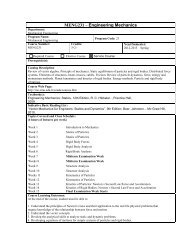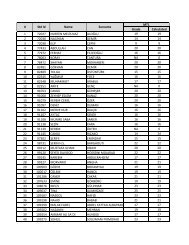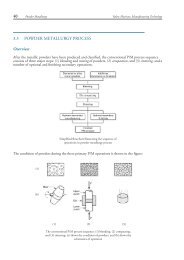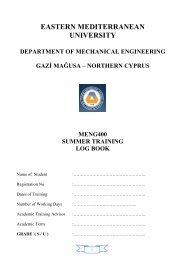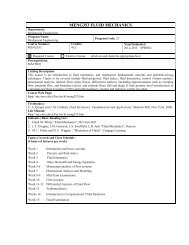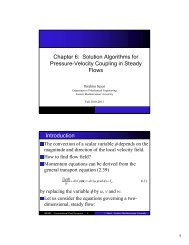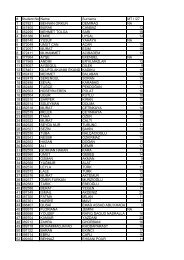Lab sheet #2 - Department of Mechanical Engineering
Lab sheet #2 - Department of Mechanical Engineering
Lab sheet #2 - Department of Mechanical Engineering
Create successful ePaper yourself
Turn your PDF publications into a flip-book with our unique Google optimized e-Paper software.
EASTERN MEADITERRANEAN UNI VERSTY<br />
DEPARTMENT OF MECHANICAL ENGINEERING<br />
LABORATORY HANDO UT<br />
1979<br />
COURSE Materials Science MENG 286/182<br />
Semester: Fall 2009/2010<br />
<strong>Lab</strong>oratory No: 2<br />
Name <strong>of</strong> Exp: Hardness Test<br />
Instructor: Cafer Kizilors<br />
Submitted by: <br />
Student No: <br />
Date: ..<br />
-------------------------------------------------------------------------------------------------------------<br />
EVALUATION<br />
PROCEDURE<br />
RESULTS & GRAPHS<br />
DISCUSSION<br />
OVERALL MARK<br />
Name and signature (<strong>of</strong> evaluator): ...
1. PURPOSE OF EXPERIMENT<br />
The object is to determine the hardness <strong>of</strong> a material (steel, aluminum etc.) for different<br />
scales.<br />
2. THEORY<br />
The hardness <strong>of</strong> a material can be defined as The resistance to permanent plastic<br />
deformation. There are three general types <strong>of</strong> hardness measurements depending on the<br />
manner in which the test is conducted. These are (1) scratch hardness, (2) indentation<br />
hardness and (3) rebound or dynamic hardness. Only indentation hardness is <strong>of</strong> major<br />
engineering interest for metals. Scratch hardness is measured according to Mohs scale.<br />
This consists <strong>of</strong> ten standard minerals arranged in the order <strong>of</strong> their ability to be<br />
scratched. The s<strong>of</strong>test mineral in this scale is talc (Scratch hardness 1), while diamond<br />
has a hardness <strong>of</strong> 10. A fingernail has a value about 2, annealed copper has a value <strong>of</strong> 3<br />
and martensite a hardness 7. The hardest metals fall in the Mohs hardness range <strong>of</strong> 4 to<br />
8. In dynamic hardness measurements, the indenter is usually dropped on to the metal<br />
surface, and the hardness is expressed as the energy <strong>of</strong> impact.<br />
In the indentation hardness measurements, the hardness <strong>of</strong> a metal is measured by forcing<br />
an indenter into its surface. The indenter material, which is usually a ball, pyramid or<br />
cone, is made <strong>of</strong> a material much harder than the material being tested. For example<br />
hardened steel, tungsten carbide, or diamond is commonly used. In this test, the indenter<br />
is forced into the surface <strong>of</strong> the material under a standard load at right angle (90°). After<br />
the indentation has been made, the indenter is withdrawn from the surface. An empirical<br />
hardness number is then calculated or read <strong>of</strong>f a dial, which is based on the crosssectional<br />
area or depth <strong>of</strong> the impression.<br />
Brinell Hardness Testing<br />
In this test, a hardened steel ball is forced into the surface <strong>of</strong> material under a standard<br />
load at right angle. After the indentation has been made, the indenter is withdrawn from<br />
the surface and the diameter <strong>of</strong> spherical indentation is measured. The numerical Brinell<br />
Hardness (HB) number is equal to the applied load P, divided by the spherical surface<br />
area <strong>of</strong> the indentation A, expressed in kg/mm².<br />
1


